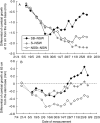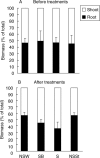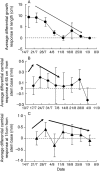Mechanical stimuli regulate the allocation of biomass in trees: demonstration with young Prunus avium trees
- PMID: 18448448
- PMCID: PMC2710262
- DOI: 10.1093/aob/mcn054
Mechanical stimuli regulate the allocation of biomass in trees: demonstration with young Prunus avium trees
Abstract
Background and aims: Plastic tree-shelters are increasingly used to protect tree seedlings against browsing animals and herbicide drifts. The biomass allocation in young seedlings of deciduous trees is highly disturbed by common plastic tree-shelters, resulting in poor root systems and reduced diameter growth of the trunk. The shelters have been improved by creating chimney-effect ventilation with holes drilled at the bottom, resulting in stimulated trunk diameter growth, but the root deficit has remained unchanged. An experiment was set up to elucidate the mechanisms behind the poor root growth of sheltered Prunus avium trees.
Methods: Tree seedlings were grown either in natural windy conditions or in tree-shelters. Mechanical wind stimuli were suppressed in ten unsheltered trees by staking. Mechanical stimuli (bending) of the stem were applied in ten sheltered trees using an original mechanical device.
Key results: Sheltered trees suffered from poor root growth, but sheltered bent trees largely recovered, showing that mechano-sensing is an important mechanism governing C allocation and the shoot-root balance. The use of a few artificial mechanical stimuli increased the biomass allocation towards the roots, as did natural wind sway. It was demonstrated that there was an acclimation of plants to the imposed strain.
Conclusions: This study suggests that if mechanical stimuli are used to control plant growth, they should be applied at low frequency in order to be most effective. The impact on the functional equilibrium hypothesis that is used in many tree growth models is discussed. The consequence of the lack of mechanical stimuli should be incorporated in tree growth models when applied to environments protected from the wind (e.g. greenhouses, dense forests).
Figures









Similar articles
-
The influence of severe shoot pruning on growth, carbon and nitrogen status in young peach trees (Prunus persica).Tree Physiol. 2002 Dec;22(18):1289-96. doi: 10.1093/treephys/22.18.1289. Tree Physiol. 2002. PMID: 12490426
-
Recycling of nitrogen in the xylem of Prunus avium trees starts when spring remobilization of internal reserves declines.Tree Physiol. 2003 Oct;23(15):1061-8. doi: 10.1093/treephys/23.15.1061. Tree Physiol. 2003. PMID: 12975130
-
Gas exchange, biomass, whole-plant water-use efficiency and water uptake of peach (Prunus persica) seedlings in response to elevated carbon dioxide concentration and water availability.Tree Physiol. 2002 Jul;22(10):699-706. doi: 10.1093/treephys/22.10.699. Tree Physiol. 2002. PMID: 12091151
-
Changes in Root-Shoot Allometric Relations in Alpine Norway Spruce Trees After Strip Cutting.Front Plant Sci. 2021 Aug 27;12:703674. doi: 10.3389/fpls.2021.703674. eCollection 2021. Front Plant Sci. 2021. PMID: 34512688 Free PMC article.
-
The early spring N uptake of young peach trees (Prunus persica) is affected by past and current fertilizations and levels of C and N stores.Tree Physiol. 2014 Jan;34(1):61-72. doi: 10.1093/treephys/tpt109. Epub 2013 Dec 18. Tree Physiol. 2014. PMID: 24353084
Cited by
-
Pervasive growth reduction in Norway spruce forests following wind disturbance.PLoS One. 2012;7(3):e33301. doi: 10.1371/journal.pone.0033301. Epub 2012 Mar 7. PLoS One. 2012. PMID: 22413012 Free PMC article.
-
Strain mechanosensing quantitatively controls diameter growth and PtaZFP2 gene expression in poplar.Plant Physiol. 2009 Sep;151(1):223-32. doi: 10.1104/pp.109.138164. Epub 2009 Jul 1. Plant Physiol. 2009. PMID: 19571311 Free PMC article.
-
Deciphering the role of mechanosensitive channels in plant root biology: perception, signaling, and adaptive responses.Planta. 2023 Oct 25;258(6):105. doi: 10.1007/s00425-023-04261-6. Planta. 2023. PMID: 37878056 Review.
-
Between Stress and Response: Function and Localization of Mechanosensitive Ca2+ Channels in Herbaceous and Perennial Plants.Int J Mol Sci. 2021 Oct 13;22(20):11043. doi: 10.3390/ijms222011043. Int J Mol Sci. 2021. PMID: 34681698 Free PMC article. Review.
-
Internode elongation and strobili production of Humulus lupulus cultivars in response to local strain sensing.Sci Rep. 2021 Apr 27;11(1):9017. doi: 10.1038/s41598-021-88720-8. Sci Rep. 2021. PMID: 33907286 Free PMC article.
References
-
- Benoit Y, Dirol D. Le guide de reconnaissance des bois de France. Paris: Eyrolles, CTBA edn; 2000.
-
- Bergez JE. Influence de protections individuelles à effet de serre sur la croissance de jeunes arbres. Interprétations physiologiques et perspectives d'amélioration des protections. France: USTL, Montpellier; 1993. Ph.D. thesis.
-
- Bergez JE, Dupraz C. Effect of ventilation on growth of Prunus avium seedlings grown in treeshelters. Agricultural and Forest Meteorology. 2000;104:199–214.
-
- Biddington NL. A review of mechanically induced stress in plants. Scientific Horticulturae. 1985;36:12–20.
-
- Biddington NL, Dearman AS. The effects of mechanically-induced stress and plant growth regulators on the growth of lettuce, cauliflower and bean (Phaseolus vulgaris L.) plants. Plant Growth Regulation. 1987;5:183–194.

